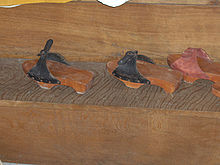Shoes have traditionally been made from leather, wood or canvas, but are increasingly made from rubber, plastics, and other petrochemical-derived materials.
The foot contains more bones than any other single part of the body. Though it has evolved over hundreds of thousands of years in relation to vastly varied terrain and climate conditions, the foot is still vulnerable to environmental hazards such as sharp rocks and hot ground, against which shoes can protect.
Many early natives in North America wore a similar type of footwear known as the moccasin. These are tight-fitting, soft-soled shoes typically made out of leather or bison hides. Many moccasins were also decorated with various beads and other adornments. Moccasins were not designed to get wet, and in wet weather and warm summer months, most Native Americans went barefoot.
While thong sandals were commonly worn, many people in ancient times, such as the Egyptians, Hindu and Greeks, saw little need for footwear, and most of the time, preferred being barefoot. The Egyptians and Hindus made some use of ornamental footwear, such as a soleless sandal known as a "Cleopatra", which did not provide any practical protection for the foot. The ancient Greeks largely viewed footwear as self-indulgent, unaesthetic and unnecessary. Shoes were primarily worn in the theater, as a means of increasing stature, and many preferred to go barefoot.[10] Athletes in the Ancient Olympic Games participated barefoot – and naked.[11] Even the gods and heroes were primarily depicted barefoot, and the hoplite warriors fought battles in bare feet and Alexander the Great conquered his vast empire with barefoot armies. The runners of Ancient Greece are also believed to have run barefoot. Pheidippides, the first marathoner, ran from Athens to Sparta in less than 36 hours.[12] After the Battle of Marathon, he ran straight from the battlefield to Athens to inform the Athenians of the news.[13]
The Romans, who eventually conquered the Greeks, and adopted many aspects of their culture, did not adopt the Greek perception of footwear and clothing. Roman clothing was seen as a sign of power, and footwear was seen as a necessity of living in a civilized world, although the slaves and paupers usually went barefoot.[10] There are many references to shoes being worn in the Bible. During weddings of this period, a father would give his son-in-law a pair of shoes, to symbolize the transfer of authority.[14] Slaves were also commonly barefoot, and shoes were considered badges of freedom since biblical times:
A common casual shoe in the Pyrenees during the Middle Ages are espadrilles. These are sandals with braided jute soles and a fabric upper portion, and often includes fabric laces that tie around the ankle. The term is French and comes from the esparto grass. The shoes originate in the Catalonian region of Spain as early as the 13th century, and were commonly worn by peasants in the farming communities in the area.[9]

Dutch pattens, ca. 1465. Excavated from the archeological site of Walraversijde, near Ostend, Belgium
Many medieval shoes were made using the turnshoe method of construction, in which the upper was turned flesh side out, and was lasted onto the sole and joined to the edge by a seam. The shoe was then turned inside-out so that the grain was outside. Some shoes were developed with toggled flaps or drawstrings to tighten the leather around the foot for a better fit. The turnshoe method was replaced by the welted method around 1500.[17]
Eventually the modern shoe, with a sewn-on sole, was devised. Since the 17th century, most leather shoes have used a sewn-on sole. This remains the standard for finer-quality dress shoes today. Until around 1800, shoes were made without differentiation for the left or right foot. Such shoes are now referred to as "straights".[18] Only gradually did the modern foot-specific shoe become standard.
Since the mid-20th Century, advances in rubber, plastics, synthetic cloth, and industrial adhesives have allowed manufacturers to create shoes that stray considerably from traditional crafting techniques. Leather, which had been the primary material in earlier styles, has remained standard in expensive dress shoes, but athletic shoes often have little or no real leather. Soles, which were once laboriously hand-stitched on, are now more often machine stitched or simply glued on. Many of these newer materials, such as rubber and plastics, have made shoes less biodegradable. It is estimated that most mass-produced shoes require 1000 years to degrade in a landfill.[19] Recently some shoemakers have picked up on the issue and are beginning to produce shoes made entirely from degradable materials, such as the Nike Considered.[20][21]
In 2007, the global shoe industry had an overall market of $107.4 billion, in terms of revenue, and is expected to grow to $122.9 billion by the end of 2012. Shoe manufacturers in the People's Republic of China account for 63% of production, 40.5% of global exports and 55% of industry revenue. However, many manufacturers in Europe dominate the higher-priced, higher value-added end of the market.




No comments:
Post a Comment